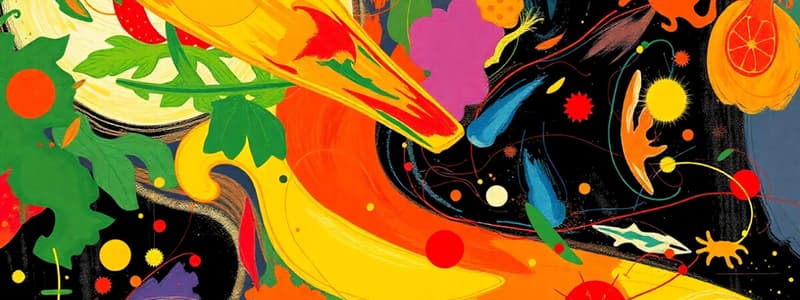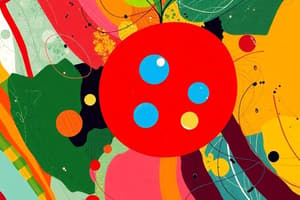Podcast
Questions and Answers
In a lab setting, a student performs a food test and observes a colour change from orange-brown to blue-black. Which substance is most likely present in the food sample?
In a lab setting, a student performs a food test and observes a colour change from orange-brown to blue-black. Which substance is most likely present in the food sample?
- Starch (correct)
- Glucose
- Protein
- Lipids
A researcher is analysing a food sample and needs to confirm the presence of lipids. Following the correct procedure, which observation would indicate a positive result?
A researcher is analysing a food sample and needs to confirm the presence of lipids. Following the correct procedure, which observation would indicate a positive result?
- A colour change from orange-brown to blue-black
- A colour change from blue to violet
- A colour change from blue to orange
- A cloudy emulsion forming (correct)
A student is tasked with identifying an unknown substance in a solution. Upon adding Biuret solution, the sample turns violet. This indicates the presence of which macromolecule?
A student is tasked with identifying an unknown substance in a solution. Upon adding Biuret solution, the sample turns violet. This indicates the presence of which macromolecule?
- Proteins (correct)
- Fats
- Complex carbohydrates
- Simple sugars
In a laboratory experiment, a student is testing a solution for the presence of glucose. After adding Benedict's solution and heating the mixture, what colour change would indicate a high concentration of glucose?
In a laboratory experiment, a student is testing a solution for the presence of glucose. After adding Benedict's solution and heating the mixture, what colour change would indicate a high concentration of glucose?
When preparing a solid food sample for testing, which step ensures that the substances in the food can react properly with the test solutions?
When preparing a solid food sample for testing, which step ensures that the substances in the food can react properly with the test solutions?
Flashcards
Sample Preparation
Sample Preparation
Crush, dissolve in distilled water, stir, and filter to get a solution for testing.
Benedict's Test
Benedict's Test
A test for glucose where Benedict's solution is added to a sample, and a positive result turns the solution orange/brick red.
Iodine Test
Iodine Test
A test for starch where iodine solution is added to a sample, and a positive result turns the solution blue-black.
Biuret Test
Biuret Test
Signup and view all the flashcards
Ethanol Emulsion Test
Ethanol Emulsion Test
Signup and view all the flashcards
Study Notes
- Method to prepare a solid food sample for food testing:
- Use a pestle and mortar to break up the food
- Transfer to a test tube and add distilled water
- Mix the food with the water using a glass rod
- Filter the mixture using a funnel and filter paper, collecting the solution
Test for Glucose: Benedict’s Solution
- Add Benedict’s solution to the sample solution in a test tube
- A positive test is indicated by a color change from blue to orange or brick red
Test for Starch: Iodine Solution
- Add drops of iodine solution to the food sample
- A positive test is indicated by a color change from orange-brown to blue-black
Test for Protein: Biuret Solution
- Add drops of Biuret solution to the food sample
- A positive test is indicated by a color change from blue to violet or purple
Test for Lipids (Fat): Ethanol
- Mix the food sample with 4cm3 of ethanol and shake
- Allow time for the sample to dissolve in the ethanol
- A positive test is indicated by a cloudy emulsion forming
Studying That Suits You
Use AI to generate personalized quizzes and flashcards to suit your learning preferences.




